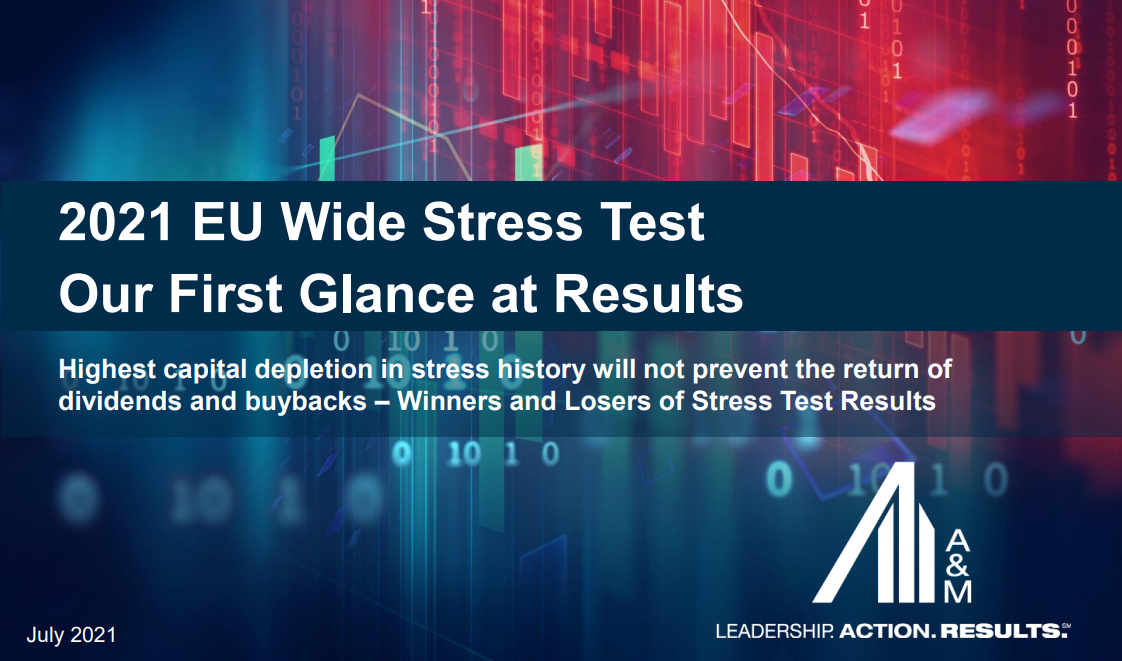2021 EU Wide Stress Test Exercise for Banks - First Glance at Results
The European Banking Authority (EBA) published the 2021 EU-wide stress test results, which involved 50 banks from 15 EU and EEA countries, covering 70% of the EU banking sector assets. This exercise allows to assess, in a consistent way, the resilience of EU banks over a three-year horizon under both a baseline and an adverse scenario, which is characterised by severe shocks taking into account the impact of the pandemic.
The highest capital depletion in stress history will not prevent the return of dividends and buybacks – Winners and Losers of Stress Test Results
“The stress test results show the highest capital depletion in stress test history (CET1 average decline of 485bps, 91bps higher than in 2018). However, this is easily explained by a more severe scenario and worse starting point due to the impact of Covid-19.”
- Top 5 countries with most depletion: Denmark, Ireland, Italy, Germany, and France
- Top 5 countries with least depletion: Poland, Norway, Spain, Sweden, and Hungary
“Despite record-breaking capital depletion, strong initial capital positions and capital buffers post-stress mean that most European banks can start paying dividends and paybacks at rates close to pre-pandemic levels.”
“As expected, results do not bring any surprise for the market and demonstrate strong resilience of the sector coming off Covid-19. We expect investors to focus on new P2G levels as the key driver for capital buffers available for distribution via dividends and buybacks. There are winners and losers in this area. Of the 8 European G-SIBs that participated, we provide the ranking below based on capital excess over total regulatory capital requirements (SREP+P2G)
- Credit Agricole +5.69%
- BPCE +4.78%
- ING +4.41%
- Unicredit +3.89%
- BNP +2.11%
- SocGen +1.91%
- Santander +1.39%
- Deutsche +1.38%
“In the future, ECB will turn its attention to climate risk stress tests in 2022. In addition, Basel IV and new features such as dynamic balance sheet and internal capital views will be considered in the next capital stress test to be performed in 2023.”
Read more - 2021 EU Wide Stress Test - First Glance at Results

In an article for Reuters, Fernando de la Mora, provides commentary on the EU bank stress test.
“Among top banks, France's Credit Agricole (CAGR.PA) and BPCE and the Netherlands' ING showed the largest capital buffers over requirements, giving them room for larger payouts via dividends and buybacks.“ Fernando de la Mora, Managing Director.
This stress test was initially scheduled for 2020 but postponed by one year as part of the temporary relief measures decided by the EBA due to the pandemic. Instead, in 2020, the EBA has released two Transparency exercises (in late Spring and Autumn) to inform the public on the conditions of the EU banking sector at the start of the COVID-19 crisis and the impact of the crisis in the first half of 2020, without any additional reporting burden for banks. In addition, in May 2020, the EBA published a Thematic Note (EBA Rep/2020/17) analysing the preliminary effects of the COVID-19 pandemic on the EU banking sector, including a sensitivity analysis on parts of banks’ credit and market risk portfolios.




